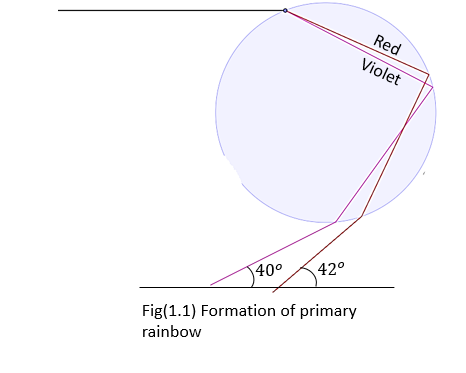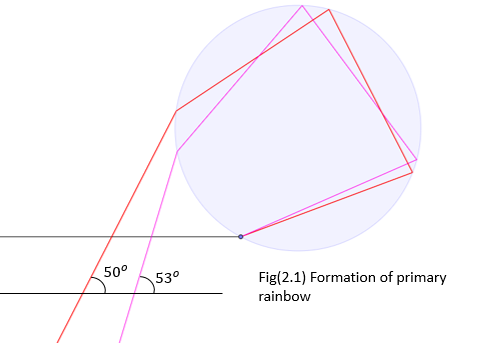
What is a rainbow? Draw a labelled diagram to show the formation of a rainbow.
Answer
505.8k+ views
Hint: The formation of rainbow involves three important processes – Refraction, Dispersion and total internal reflection. Dispersion is the splitting of light into its component colours as it passes through a medium.
Complete step by step answer:
Rainbow is a colourful band that appears in the sky due to the dispersion of sunlight by water droplets. They are usually seen when the sun comes out just after a rain or when both rain and sun come together.
We know that lights of different wavelengths have different speeds in some transparent media. Such a medium where the speed of a wave is dependent on wavelength is called a dispersive medium. Water and glass are examples of such a medium. Due to this difference in speeds, the refractive index of water for different wavelengths also differ. The dependency of refractive index on wavelength is given as
Thus, lights of different wavelengths bend differently when they pass through a water droplet. This phenomenon, called dispersion, is the main cause of the formation of a rainbow.
A rainbow is formed when white light from the sun passes through water droplets present in the sky. The light rays could enter a droplet either from the lower or from the upper side. This gives us two types of rainbows.
Primary rainbow:

Here, the light enters the top half of the droplet. As the ray enters, it suffers refraction due to change in material. But as we have seen, different wavelengths present in the ray would deviate differently and dispersion occurs resulting in the splitting of the ray into component colours. The red light undergoes minimum deviation whereas the violet undergoes maximum deviation. The split rays now undergo Total internal reflection at the water-air interface and bounce back and refract again before coming out of the droplet. We can see from fig(1.1) that the rays coming out are diverging and make different angles with the incident sunlight. Since the rays are diverging, we won't be able to see both these rays together. We would be seeing red light coming from a higher droplet and violet light coming from a lower droplet .
So in a primary rainbow, Violet is at the bottom and red is at the top and the angular width of the rainbow is
Secondary rainbow:

This is formed when the light ray incident hits the bottom half of the raindrop. The light first undergoes refraction and dispersion, splitting itself into its component colours. Then, the rays hit the water-air interface and undergo two successive Total internal Reflections. As we see in the diagram, this results in red light being at the top and violet at the bottom. Again, both these diverging rays cannot be seen together. We see violet rays that come from a higher droplet and red from a lower droplet.
This creates an inverted rainbow, with violet on top and red at the bottom. We can also see that the angular width of this rainbow is
Also, since the primary rainbow occurs at
Note: Every droplet that makes an angle between
Complete step by step answer:
Rainbow is a colourful band that appears in the sky due to the dispersion of sunlight by water droplets. They are usually seen when the sun comes out just after a rain or when both rain and sun come together.
We know that lights of different wavelengths have different speeds in some transparent media. Such a medium where the speed of a wave is dependent on wavelength is called a dispersive medium. Water and glass are examples of such a medium. Due to this difference in speeds, the refractive index of water for different wavelengths also differ. The dependency of refractive index on wavelength is given as
Thus, lights of different wavelengths bend differently when they pass through a water droplet. This phenomenon, called dispersion, is the main cause of the formation of a rainbow.
A rainbow is formed when white light from the sun passes through water droplets present in the sky. The light rays could enter a droplet either from the lower or from the upper side. This gives us two types of rainbows.
Primary rainbow:

Here, the light enters the top half of the droplet. As the ray enters, it suffers refraction due to change in material. But as we have seen, different wavelengths present in the ray would deviate differently and dispersion occurs resulting in the splitting of the ray into component colours. The red light undergoes minimum deviation whereas the violet undergoes maximum deviation. The split rays now undergo Total internal reflection at the water-air interface and bounce back and refract again before coming out of the droplet. We can see from fig(1.1) that the rays coming out are diverging and make different angles with the incident sunlight. Since the rays are diverging, we won't be able to see both these rays together. We would be seeing red light coming from a higher droplet and violet light coming from a lower droplet .
So in a primary rainbow, Violet is at the bottom and red is at the top and the angular width of the rainbow is
Secondary rainbow:

This is formed when the light ray incident hits the bottom half of the raindrop. The light first undergoes refraction and dispersion, splitting itself into its component colours. Then, the rays hit the water-air interface and undergo two successive Total internal Reflections. As we see in the diagram, this results in red light being at the top and violet at the bottom. Again, both these diverging rays cannot be seen together. We see violet rays that come from a higher droplet and red from a lower droplet.
This creates an inverted rainbow, with violet on top and red at the bottom. We can also see that the angular width of this rainbow is
Also, since the primary rainbow occurs at
Note: Every droplet that makes an angle between
Recently Updated Pages
Express the following as a fraction and simplify a class 7 maths CBSE

The length and width of a rectangle are in ratio of class 7 maths CBSE

The ratio of the income to the expenditure of a family class 7 maths CBSE

How do you write 025 million in scientific notatio class 7 maths CBSE

How do you convert 295 meters per second to kilometers class 7 maths CBSE

Write the following in Roman numerals 25819 class 7 maths CBSE

Trending doubts
Give 10 examples of unisexual and bisexual flowers

Draw a labelled sketch of the human eye class 12 physics CBSE

Differentiate between homogeneous and heterogeneous class 12 chemistry CBSE

Differentiate between insitu conservation and exsitu class 12 biology CBSE

What are the major means of transport Explain each class 12 social science CBSE

Franz thinks Will they make them sing in German even class 12 english CBSE




